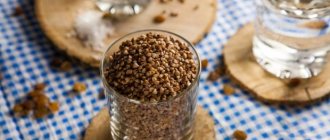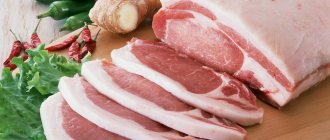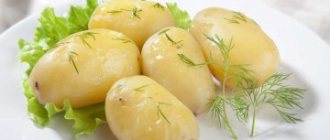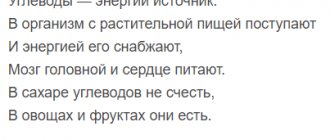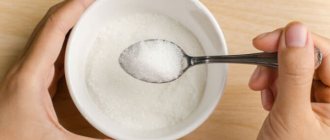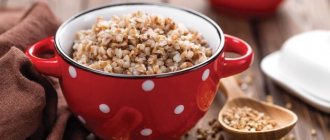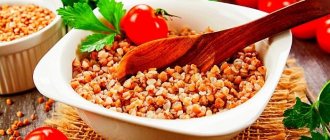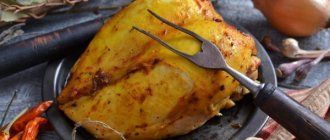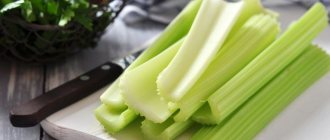Buckwheat was brought to us from Greece, which is why it got its name – buckwheat. Buckwheat is produced from the cereal crop - buckwheat, by cleaning the grain from the hard shell. Buckwheat stores well, does not go rancid, and is widely used for preparing various dishes.
After cleaning, the grain can be steamed, roasted or crushed. But vitamins are best preserved in unfried whole grains - buckwheat.
Despite its high calorie content, buckwheat is a dietary product due to its balanced combination of nutrients and fiber.
Table: calorie content of dry buckwheat, 100 grams of product contains:
| How much fat? | 2.6 g |
| How many carbohydrates? | 68 g |
| How many proteins? | 12.6 g |
| Total calories | 345 kcal |
Carbohydrates in cereals take longer to digest, which is why they are called “slow”; they create a feeling of fullness for a long time, which promotes weight loss. Many dishes are prepared from buckwheat: with milk, with mushrooms, with meat, with stew, with onions and vegetables - it goes well with a variety of products.
With milk
| Name | Quantity | fats | carbohydrates | squirrels | Total kcal |
| Buckwheat (half a glass) | 110 gr | 1.3 | 34 | 6.3 | 173 |
| Milk (1 glass) | 240 ml | 10.36 | 0 | 7.68 | 124 |
| Water (1 glass) | 240 ml | 0 | 0 | 0 | 0 |
| Sugar (1 tablespoon) | 30 gr | 0 | 29.9 | 0 | 119 |
| Total calories per 2 servings/270 grams | 550 | 105 | 255 | 56 | 416 |
Traditionally, porridge is cooked in milk; this also applies to buckwheat; 100 grams of buckwheat with milk contains only 76 kcal. To improve the taste, buckwheat porridge with milk can be seasoned with butter, then the taste will become even more delicate. The calorie content of boiled buckwheat porridge with milk, butter and sugar increases by about 50 kcal/100 grams.
How many carbohydrates are in 100 grams of boiled buckwheat in water?
When counting carbohydrates in buckwheat, you must remember that their content depends on the cooking method. 100 g of buckwheat contains:
- raw – 71.5 g carbohydrates;
- after heat treatment – 20 g.
When broken down in the body, the substances contained in cereals release a huge amount of energy, which can provide energy for the whole day. The main source of energy in buckwheat is starch. Its peculiarity is its slow disintegration, accompanied by a large release of energy. The product also contains a large amount of fibers, which have a beneficial effect:
- to balance sugar levels;
- weight normalization;
- reducing the risk of heart disease;
- reducing cholesterol levels.
With stew
| Name | Quantity | fats | carbohydrates | squirrels | Total kcal |
| Buckwheat (2.5 cups) | 500 gr | 13 | 340 | 63 | 1729 |
| Stew (1 can) | 400 gr | 69.6 | 0 | 56.4 | 852 |
| Water (5 glasses) | 1.2 l | 0 | 0 | 0 | 0 |
| Onion (2 pcs) | 200 gr | 0 | 20.8 | 2.8 | 96 |
| Carrots (1 piece) | 100 gr | 0.1 | 6.9 | 1.3 | 35 |
| Volume. pasta (3 tablespoons) | 100 gr | 1.5 | 16.7 | 5.6 | 104 |
| Butter (3 tablespoons) | 100 gr | 82.5 | 0.8 | 0.5 | 744 |
| Total calories in 9 servings/250 grams | 2350 gr | 1500 | 1540 | 519 | 3560 |
100 grams of buckwheat with stew contains 151 kcal.
Stewed dishes are universal, easy to prepare and valued for their high taste.
The benefits of buckwheat and its types
Buckwheat is an environmentally friendly product, which is rare nowadays. No chemical additives are required for its sowing and cultivation. Cereals contain a lot of protein - 18 amino acids. In composition it is very close to animal protein.
Useful properties of buckwheat:
- Reduces the risk of developing malignant tumors.
- Increases the body's resistance to adverse environmental factors.
- Accelerates the healing of the gastric mucosa.
- Increases hemoglobin.
- Reduces the risk of thrombosis.
- Controls blood sugar levels.
- Strengthens the nervous and immune system of the body.
- It prevents tachycardia.
- Seals the walls of blood vessels.
Types of buckwheat:
- Yadritsa (or polished) is the buckwheat that we are used to seeing on store shelves. It is cleared of husks, therefore it is presented in the form of whole or split grains. This type of buckwheat is preferred by many housewives; it is easy to wash.
- Prodel (chaff) is crushed grains, so the porridge turns out more tender. It cooks much faster than kernels.
- Green buckwheat is an unprocessed grain.
- Buckwheat flakes are crushed grains that have undergone heat treatment. Suitable for porridges and breads.
- Buckwheat flour is a very finely ground grain. Mainly used for baking.
With vegetables
| Name | Quantity | fats | carbohydrates | squirrels | Total kcal |
| Buckwheat (1 cup) | 220 gr | 5.72 | 150 | 27.7 | 760 |
| Water (2 glasses) | 480 ml | 0 | 0 | 0 | 0 |
| Carrots (1 piece) | 100 gr | 0.1 | 6.9 | 1.3 | 35 |
| Bow (1 piece) | 100 gr | 0 | 10.4 | 1.40 | 47.2 |
| Tomato (1 piece) | 100 gr | 0.2 | 4.2 | 0.6 | 21 |
| Sweet pepper (1 piece) | 100 gr | 0 | 5.3 | 1.3 | 26.4 |
| Sunflower oil (3 tablespoons) | 100 ml | 99.86 | 0 | 0 | 898.7 |
| Total calories in 4 servings of 260 grams | 1100 gr | 952 | 707 | 129 | 1789 |
Juicy buckwheat with bright, healthy and low-calorie vegetables is a wonderful alternative to regular porridge, calorie content is only 162 kcal per 100 grams.
If you need to reduce calories, try using less oil.
- We recommend reading: cleansing the body with buckwheat and kefir
Interesting Facts
The regions of Nepal and India are considered to be the birthplace of the cereal, where buckwheat has been eaten for more than four thousand years. As for Russia, the plant came here later and, as you can easily guess from the name, Greece became the source country.
Buckwheat itself is buckwheat kernels obtained by separating the central part from the shells of the fruit. Depending on the quality of the source and the method of extraction, buckwheat is distinguished into three grades, where the first grade is considered the most “clean” and healthy.
Sources
- https://tonustela.net/calorific-value/cereals/grechka.html
- https://agronom.expert/posadka/ogorod/drugie-rasteniya/grechka/skolko-kaloriy-soderzhitsya-v-grechke-varenoy-na-vode.html
- https://vsudu-sport.ru/pitanie/poleznye-produkty/kaloriynost-grechki
- https://fruitree.ru/obrabotka-sadovyh-kultur/skolko-kalorij-v-varenoj-grechke.html
- https://Proteinfo.ru/voprosy-pitaniya/produkty-i-sostav/skolko-belka-v-grechke/
- https://NaLugah.ru/zernovye/grechka/skolko-kalorij-v-grechke.html
- https://fitburn.ru/pitanie/pp/grechka-otvarnaya-kalorijnost-i-soderzhanie-bzhu-na-100-gramm.html
- https://cross.expert/zdorovoe-pitanie/produkty-pitaniya/grechka.html
- https://kprfrd.su/svojstva-produktov/skolko-kalorij-v-grechke.html
With meat
| Name | Quantity | fats | carbohydrates | squirrels | Total kcal |
| Buckwheat (2.5 cups) | 500 gr | 13 | 340 | 63 | 1729 |
| Fillet of beef | 500 gr | 62 | 0 | 94.5 | 936 |
| Bow (1 piece) | 100 gr | 0 | 10.4 | 1.40 | 47.2 |
| Carrots (1 piece) | 100 gr | 0.1 | 6.9 | 1.3 | 35 |
| Tomato. pasta (3 tbsp.) | 100 gr | 1.5 | 16.7 | 5.6 | 104 |
| Water (6 glasses) | 1.4 l | 0 | 0 | 0 | 0 |
| Vegetable oil (2 tablespoons) | 60 ml | 59.91 | 0 | 0 | 539 |
| Total calories per 10 servings/250 grams | 2500 gr | 1228 | 1496 | 663 | 3390 |
Buckwheat with meat turns out especially tasty if you bake it in pots; the energy value is only 135 kcal per 100 grams.
Calorie table for second courses
Lunch should be the most satisfying meal of the day, but moderate in calories. The category of “highest fat and high-calorie dishes” listed in the table includes fried pork cutlets, breaded chicken and fish, and fast food from McDonald’s.
Calorie table for second courses
| Name of the dish | kcalCalories per 100 g | BProteins, g | ZhBir, g | Carbohydrates, g |
| Beef Goulash | 156,7 | 14,7 | 10,6 | 3,1 |
| Pork goulash | 237,3 | 13,9 | 16,6 | 3,2 |
| Steamed chicken cutlets | 127,5 | 14,9 | 5,2 | 2,7 |
| Fried chicken cutlets | 177,6 | 14,8 | 8,1 | 2,8 |
| Steamed turkey cutlets | 138,9 | 15 | 6,7 | 2,7 |
| Steamed fish cutlets | 86,8 | 14,6 | 1,6 | 2,9 |
| Fried fish cutlets | 142,3 | 14,5 | 5,9 | 2,9 |
| Steamed beef cutlets | 128,6 | 16,1 | 6,2 | 2,7 |
| Steamed pork cutlets | 203,3 | 15,2 | 10,9 | 3,1 |
| Chicken chop | 187,2 | 17,6 | 8,9 | 5,4 |
| Pork chop | 249,1 | 19,2 | 15,9 | 1,4 |
| Grilled or baked chicken | 179,8 | 18,3 | 8,3 | |
| Pork stewed or steamed | 256,5 | 13,8 | 18,1 | 3,4 |
| Beef stew | 178,9 | 14,7 | 12,4 | 3,2 |
| Cabbage rolls with minced meat and rice | 222,4 | 7,1 | 14,6 | 12,9 |
| Stuffed peppers | 179,8 | 6,9 | 11,1 | 10,1 |
| Liver stewed in sour cream | 151,1 | 16,2 | 6,8 | 5,6 |
| Fried liver with onions | 188,1 | 16,1 | 9,9 | 5,9 |
| Pollock fried in batter | 194,8 | 16,2 | 10,8 | 6,3 |
| Fried cod | 122,3 | 16,3 | 5,3 | 0,3 |
| Steamed salmon | 195,1 | 18,8 | 13,2 | |
| Baked pink salmon | 138,3 | 19,5 | 6,2 | |
| Meatballs (hedgehogs) with rice | 217,1 | 14,3 | 11,6 | 11,2 |
| Meat in French | 243,4 | 14 | 18,6 | 2,1 |
| Pilaf with chicken | 222,1 | 11,9 | 9,8 | 18,7 |
| Pilaf with pork | 265,4 | 13,2 | 12,6 | 17,3 |
| Beef pilaf | 218,8 | 13,4 | 9,1 | 18,9 |
| Cabbage stewed with meat | 143,7 | 11,1 | 5,6 | 10,5 |
| Fried potatoes with mushrooms | 122,4 | 2,6 | 7,3 | 12,9 |
| Potato dumplings | 178,1 | 3,9 | 4,5 | 32,3 |
| Dumplings with cottage cheese | 191,3 | 9,4 | 5,3 | 28,8 |
| Dumplings with cabbage | 142,2 | 3,6 | 4,1 | 23,1 |
| Homemade dumplings | 271,2 | 12,1 | 11,6 | 28,4 |
| Hamburger | 295 | 12,2 | 14,1 | 24,5 |
| California rolls | 176 | 7,1 | 8,9 | 17,2 |
| Philadelphia rolls | 142,2 | 9,1 | 6,9 | 12,9 |
When calculating the calorie content of ready-made dishes, do not forget that meat, fish and seafood contain water (especially when frozen), which increases the volume of the food. When cooked, meat loses from 15 to 40% of its original weight. Weight loss depends on the time and type of heat treatment. As for the ratio of fats and proteins in boiled and raw meat, it also does not remain unchanged.
In fried meat, the fat content increases significantly.
With mushrooms
| Name | Quantity | fats | carbohydrates | squirrels | Total kcal |
| Buckwheat (glass) | 220 gr | 5.72 | 150 | 27.7 | 760 |
| Champignon mushrooms) | 300 gr | 3 | 0.3 | 12.9 | 80 |
| Onion (2 pcs) | 200 gr | 0 | 20.8 | 2.8 | 96 |
| Vegetable oil (1 table spoon) | 30 gr | 29.96 | 0 | 0 | 270 |
| Water (2 glasses) | 480 ml | 0 | 0 | 0 | 0 |
| Total calories per 5 servings/220 grams | 1100 gr | 348 | 684 | 174 | 1206 |
Buckwheat porridge with mushrooms contains - a traditional Russian dish can be prepared with any mushrooms: dried, frozen, fresh.
The energy value of buckwheat with champignons is about 109 kilocalories per 100 grams.
The power of buckwheat
First of all, buckwheat has high nutritional value. Its composition has a structure of proteins, fats and carbohydrates that is favorable for a healthy body. It is rich in vitamins and minerals, which we so often lack.
We recommend reading the article - buckwheat diet for weight loss.
Composition according to BZHU
- Proteins are the most valuable component of cereals. 100 g of raw product contains 12.6 g of proteins (proteins). There are more essential acids - lysine and methionine - in buckwheat than in all other cereals. Its proteins are easily digestible and serve the growth of muscle rather than fat tissue. 1 gram of protein contains 4 calories.
- Fats make up 1/30 of all components of the product: per 100 g of cereal there are only 3.3 g of fat (in boiled buckwheat there is 3 times less). The main part of fats is polyunsaturated, they reduce cholesterol levels, accelerate fat metabolism and thereby promote weight loss. One gram of fat provides the body with 9 calories.
- Carbohydrates are the main component of the product - 64 g/100g. But there are no fast carbohydrates - sugar, glucose - in buckwheat. The glycemic index of cereal is 55 units - this means that the absorption of the product occurs slowly, the body consumes energy gradually, without storing excess in the form of fat reserves. Eating buckwheat dishes keeps you feeling full for a long time, which is especially important for those who are struggling with excess weight.
The composition of the BJU depends on the ingredients included in the dish with buckwheat: adding mushrooms, milk or chicken will increase the protein content. Porridge with butter and mushrooms has a lot of fat, and therefore calories; porridge with vegetables has the lowest calorie content.
Table. Nutritional value of dishes with buckwheat (per 100 g of product)
| The product's name | Proteins (g) | Fat (g) | Carbohydrates (g) |
| Buckwheat cooked in water | 3,2 | 0,8 | 17,1 |
| Porridge with added milk | 4,0 | 1,7 | 19,0 |
| Porridge with added butter | 3,6 | 5,7 | 17,8 |
| Porridge with mushrooms | 3,8 | 4,3 | 14,6 |
| Porridge with vegetables | 2,2 | 0,6 | 12,0 |
| Porridge with chicken | 15,0 | 3,8 | 5,7 |
Vitamins
Buckwheat is rich in B vitamins, without which the coordinated functioning of the nervous system is impossible. It is important that these vitamins work in combination and enhance each other’s effects.
100 g of dry cereal contains:
- 20% of the daily value of vitamin B3 (RR);
- 14% riboflavin (B2);
- about 14% pyridoxine (B6);
- 12% thiamine (B1);
- 7.5% folic acid (B9).
All vitamins in this group are important for normalizing weight, since they participate in energy metabolism with the breakdown of carbohydrates and fats.
Video
Minerals
Buckwheat supplies the body with important macro- and microelements.
100 g of dry cereal contains:
- iron (55% of the daily requirement) – an element for the synthesis of red blood cells, which provide oxygen supply to all cells;
- manganese (88% s.n.) - necessary for strengthening bone tissue and increasing immunity;
- copper (66% s.n.) is a component without which it is impossible to transport iron within the body;
- magnesium (61%) and potassium (15%) are the main elements that regulate the functioning of the heart muscle;
- phosphorus (43%) – a substance for strengthening bone tissue.
- selenium (21.5%) is a rare trace element with antibacterial and anti-inflammatory effects.
We recommend reading the article - buckwheat with kefir for weight loss.
The chemical composition of buckwheat is 1.5-3 times richer than other cereals, while it has low calorie content and is an indispensable product in dietary nutrition.
With onion
| Name | Quantity | fats | carbohydrates | squirrels | Total kcal |
| Buckwheat (glass) | 220 gr | 5.72 | 150 | 27.7 | 760 |
| Bow (1 piece) | 100 gr | 0 | 10.4 | 1.40 | 48 |
| Oil drain. (1 tbsp) | 30 gr | 24.75 | 0.24 | 0.15 | 225 |
| Water (2 glasses) | 480 ml | 0 | 0 | 0 | 0 |
| Total calories per 3 servings/240 grams | 730 | 274 | 642 | 117 | 1033 |
Tender, crumbly buckwheat with onions and dietary gravy will perfectly satisfy hunger and is suitable for those who want to lose weight, because the calorie content per 100 grams is only 141 kcal.
How to cook porridge correctly
Each housewife has her own recipe for cooking buckwheat. At the same time, it takes a lot of time to independently find the best way to prepare a healthy dish. Therefore, it is better to cook according to the general (already proven) recipe:
- Pour a glass of washed and peeled buckwheat into the pan;
- Pour 2 cups of cold water over the cereal;
- Leave the container on the stove over low heat;
- Cook the buckwheat for 15-20 minutes under a closed lid (without stirring it);
- Remove the pan from the heat and cover it with a towel or scarf.
This cooking method allows you to get crumbly and soft cereals. In addition, buckwheat can also be steamed (recipe in the first half of the article).
With Chiken
| Name | Quantity | fats | carbohydrates | squirrels | Total kcal |
| Buckwheat (glass) | 220 gr | 5.72 | 150 | 27.7 | 760 |
| Chicken carcass (1 piece) | 1.2 kg | 154 | 0 | 176 | 2090 |
| Carrots (1 piece) | 100 gr | 0.1 | 6.9 | 1.3 | 35 |
| Bow (1 piece) | 100 gr | 0 | 10.4 | 1.40 | 47.2 |
| Sunflower oil (2 tablespoons) | 60 ml | 59.91 | 0 | 0 | 539 |
| Mayonnaise (1 tbsp.) | 30 gr | 20.1 | 0.78 | 0.93 | 188 |
| Water (2 cups) | 480 ml | 0 | 0 | 0 | 0 |
| Total calories per 7 servings/220 grams | 1600 gr | 2160 | 672 | 828 | 3660 |
Chicken stuffed with buckwheat is an appetizing, aromatic and very tasty dish that is perfect for a holiday table. The energy value of buckwheat with chicken is 228 kcal/100 grams.
The fairly high calorie content of the dish can be reduced if you do not coat the chicken with mayonnaise and stew the vegetables without vegetable oil; the calorie content will decrease by about 50 kcal/100 grams.
Beneficial features
Buckwheat can be a complete substitute for meat, which is explained by its nutritional capabilities. Thanks to its rich chemical composition, it is able to saturate the human body with essential vitamins and microelements. It is recommended to include it in your daily diet to avoid many health problems.
Useful properties of buckwheat:
- Stabilizes blood pressure and hematopoiesis.
- Positively affects the musculoskeletal component.
- Activates the central nervous system and enhances brain activity.
- Serves as protection against malignant neoplasms.
- Prevents the development of cardiovascular diseases, strengthens vascular walls.
- Normalizes digestion: improves intestinal motility, relieves constipation.
- Increases immunity.
- Reduces “bad” cholesterol and hemoglobin levels in the blood.
- Cleanses away impurities and toxins.
- Uplifts your mood and energizes you.
- Helps eliminate swelling and inflammation due to arthrosis, arthritis and rheumatism.
Buckwheat dishes are recommended for constant consumption by children, which contributes to the normal development of the growing body. At the same time, mental abilities improve: concentration and memory. People involved in sports need such a nutritional supplement to gain muscle mass. This is due to the saturation of buckwheat with carbohydrates, which during the digestion process release a large supply of energy. Against this background, training is more productive.
For men, systematic consumption of buckwheat dishes will help in case of problems with potency and prevent inflammatory processes in the prostate gland.
Buckwheat is no less useful for women, as it improves appearance: it has a positive effect on the skin, structure of hair and nails. As a result, acne and irritation on the face disappear, and the skin becomes more elastic. Thanks to the cereal, hormonal levels return to normal, which is especially important during the onset of menopause and shortly before.
During pregnancy
During pregnancy, it is recommended to consume buckwheat regularly, as it is a valuable supplier of vital substances for both mother and child. Folic acid in its composition helps the proper development of the baby's central nervous system and prevents premature birth.
The high iron content makes cereal an indispensable remedy for the prevention of anemia. Its other components have a beneficial effect on the heart and blood vessels: they prevent varicose veins, control blood pressure, and protect against the development of atherosclerosis. It is impossible to gain weight on such dishes.
When breastfeeding, a woman should especially monitor her diet so as not to harm the baby. Eating buckwheat allows you to avoid many digestive problems in a newborn: bloating, colic and allergies.
When losing weight
Buckwheat is considered a dietary but nutritious product. Therefore, it is easy to lose weight on it, without the constant hunger inherent in many diets. Buckwheat dishes fill you up well and for a long time, which eliminates unnecessary snacks during the day. Despite the meager diet during such weight loss, the body does not experience much stress. This is due to the balanced and rich chemical composition of the cereal.
Intensive fat burning occurs due to:
- improving bowel function;
- enhancing metabolism;
- removal of excess fluid from the body;
- cleansing of waste and toxins.
It is enough to replace 1-2 meals a day in your usual menu with dietary buckwheat dishes, due to which you can lose up to 2 kg of excess weight in 7 days.
Content of useful elements in buckwheat
Table: content of microelements and vitamins per 100 grams of dry buckwheat
| Name | Content | Daily requirement % |
| Co (cobalt) | 3.1 mcg | 0.31 |
| PP (niacin) | 4.19 mg | 17 |
| K (potassium) | 380 mg | 19 |
| Ca (calcium) | 20 mg | 2 |
| Mg (magnesium) | 200 mg | 57 |
| B9 (folic acid) | 32 mcg | 3.2 |
| B1 (thiamine) | 0.43 mg | 29 |
| B6 (pyridoxine) | 0.4 mg | 20 |
| Fe (iron) | 6.6 mg | 44 |
| Cu (copper) | 0.64 mg | 43 |
| B2 (riboflavin) | 0.2 mg | 12 |
Buckwheat also contains manganese, chromium, silicon and zinc.
THESE ARTICLES WILL HELP YOU LOSE WEIGHT
Composition of buckwheat
Most often, buckwheat kernels are used for food - unsteamed and without husks, whole buckwheat grains of a rich brown color. This is the richest product in biochemical composition. It contains:
- starch;
- saturated and unsaturated fatty acids;
- mono- and disaccharides;
- vitamins: groups B, E, A, PP;
- micro- and macroelements: iron, phosphorus, magnesium, potassium, calcium, sodium, sulfur, silicon, iodine, zinc;
- organic acids: oxalic, citric, malic;
- arginine, lysine;
- routine;
- choline;
- folic and nicotinic acid;
- cellulose.
Harm and contraindications
Buckwheat with egg in a frying pan is a fairly simple and healthy dish, which can be harmful if consumed incorrectly. It is not recommended to abuse this dish if you are prone to flatulence and constipation, since the amount of fiber aggravates the situation and provokes bloating. It is also necessary to take into account the possible harm of chicken eggs. Insufficiently processed chicken eggs lead to infection of the body with bacteria, including salmonella.
You can also note the occurrence of an allergic reaction, despite the fact that buckwheat is a hypoallergenic product, in some cases skin rash, itching, vomiting and diarrhea may occur due to allergies. These symptoms also apply to an allergic reaction to chicken eggs.

